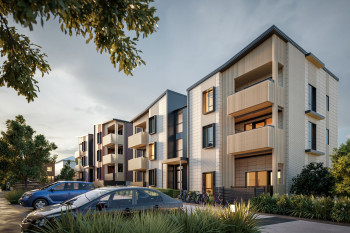New Zealand public housing pilot to feature at UN Climate Change Conference
28 October 2021
An innovative new Kāinga Ora public housing pilot tackling climate change in the built environment will feature on the world stage at the United Nations Climate Conference (COP26).
Ngā Kāinga Anamata, meaning ‘homes of the future’, is a sustainability project aimed at driving carbon emission reduction in New Zealand’s construction industry. The project has been selected as one of only 17 initiatives worldwide to be on show in the COP26 ‘Build Better Now’ virtual pavilion from October 31.
The project will deliver 30 new homes within five, three-level apartment buildings in Auckland’s Glendowie. Each near identical building will use a different construction technology1, enabling sustainability insights to be gathered on a range of building materials and systems.
Kāinga Ora Commercial Director Matt Noyes, says Ngā Kāinga Anamata has a firm focus on achieving the Government’s carbon emission targets, with significant benefits to occupants.
“The buildings will achieve significantly reduced carbon and energy outputs; achieving both Passive House standard and net zero energy,” he says.
“By focusing on the trifecta of using low carbon materials, operational energy efficient solutions and local renewable energy generation we have managed to slash lifecycle carbon emissions to a fraction of what they are in a traditionally New Zealand built home. Construction and monitoring of these buildings will now help us understand the overall cost and benefits of low-carbon public housing, and report our insights back to the industry.
“Importantly, the individuals and whānau who will live in these homes will enjoy a high performing, thermally comfortable and healthy home, and a genuine solution to fuel poverty.”

Each of the project’s five near-identical buildings will be built using a different construction technology.
Kāinga Ora Board Chair Vui Mark Gosche says global recognition of the industry-leading development is significant for Kāinga Ora.
“‘Build Better Now’ involved a rigorous selection process, and the successful projects are those making an immediate positive impact on both the planet and people’s lives. As a major property developer and public housing landlord these outcomes are critically important to Kāinga Ora,” he says.
“Ngā Kāinga Anamata seeks to resolve many underlying problems with the housing sector in Aotearoa New Zealand and is the start of a national response to climate change mitigation in the built environment.
“The homes we build today will set the path for our carbon emissions in the decades to come. We need to be part of the solution, driving innovation and transformation now to ensure good health and climate safety for future generations.”
Ngā Kāinga Anamata also aims to address biodiversity loss, actively protecting, restoring and supporting local ecosystems. Planned native biodiversity corridors and large pockets of regenerated native forest will provide a network of plant life supporting insects, birds and other animals so they can co-exist and thrive alongside the new development.
Kāinga Ora has already committed to the performance standard of achieving a 6 Homestar rating on all new builds, and Ngā Kāinga Anamata is on track to achieve 9 Homestar.
Due to begin construction in early-to-mid 2022, the public housing development will achieve MBIE’s Building for Climate Change programme targets, reaching the proposed 2030 final operational efficiency cap by 2024; six years ahead of expectation.
The ‘Build Better Now’ virtual pavilion is free and open virtual exhibition and events series highlighting the built environment’s role in tackling the climate and biodiversity/ecological crises. It will be live from 31 October at buildbetternow.co(external link)
Footnote: 1 The five construction materials used are: mass timber/cross laminated timber (CLT); light timber frame (LTF); precast concrete; light gauge steel and a hybrid CLT/LTF.
Media Contact
Page updated: 28 October 2021
